PROBABILITY OF AN EVENT.
In any experiment, depending on the number of trials.
Sample space, S
Is the set of all possible outcomes.
Example;
Tossing of dice once;
S = {1, 2, 3, 4, 5, 6}.
Tossing of coin once.
S = {H, T}.
Event, E
– Is the specified outcomes.
Example;
Tossing of a dice once the specified outcome is odd number.
Sample space, S = {1, 2, 3, 4, 5, 6}
Event, E = {1, 3, 5}
Possibility
– Is the occurrence of any expected event.
Note:
Sample space and event are usually denoted by capital letters like A, B and E.
Definition.
Possibility of an event is the ratio of number of events to the number of sample space.

Example;
A coin is tossed twice, what is the probability of getting two tails?
Solution
By using probability table.
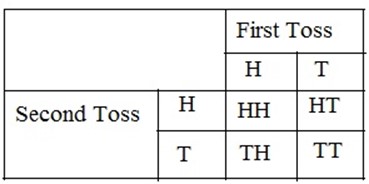
Sample space, S = {HH, HT, TH,TT}
Event, E = {TT}
Thus,
n(S) = 4, n(E) = 1

Exercise
1. Write the possibility set for each of the following experiments;
a) Expectation of the football match between two teams
b) A die is flipped and a face showing up is recorded.
2. A student is taken at random from a class of 15 boys and 10 girls. What is the probability that the student taken at random is not a girl?
3. A number between 19 and 31 inclusive is chosen at random. What is the that;
a) The number chosen is odd?
b) The number chosen is prime?
4. Taking the sample space for the total number of all possible outcomes when a pair of dice is flipped, find on a single flip of a pair of dice, the probability of obtaining;
a) A sum of ten.
b) A odd sum.
c) A sum less than fire.
COMBINED EVENTS.
Combined events are those events that can be represented by two or more simple events.
The events/outcome can easily be obtained by using a tree diagram or a table.
Example;
Use a tree diagram to list the sample space showing the possible arrangements of boys and girls in a family of exactly three children. What is the probability that,
a) All children are girls.
b) Two children are girls and one is a boy.
c) At least one of the children is a boy.
d) None of the children are girls.
Solution
The tree diagram.
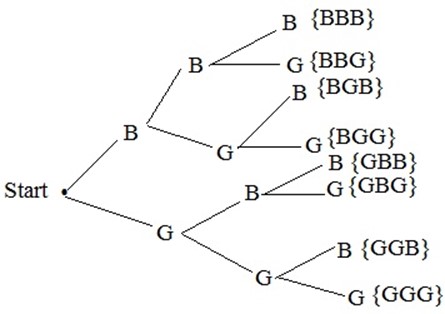
The outcome can be summarized as;
S = {BBB, BBG, BGB, BGG, GBB, GBG, GGB, GGG}.
a) E1 = {GGG}; n(S) = 8
n(E1) = 1

b) E2 = {BGG, GBG, GGB)
n(E2) = 3

c) E3 = {BBB, BBG, GBB, BGB, BGG, GBG, GGB}
n(E3) = 7

d) E4 = {BBB}
n(E4 ) = 1

Example 2:
In a single toss of a pair of dice, find the probability of obtaining a sum of
i) 9
ii) 12
iii) 9 or 12
Solution.
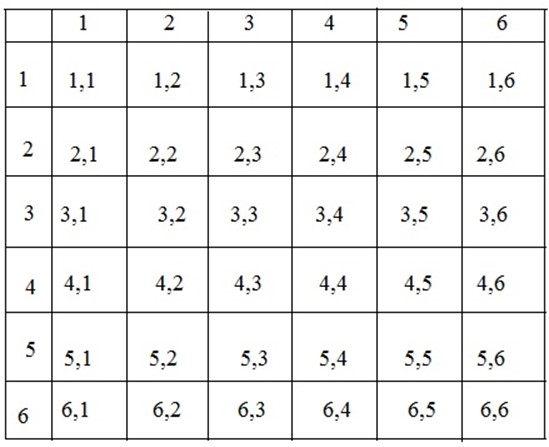
n(S) = 6 x 6 = 36
Let E1 be the event of a sum of 9
E2 be the event of a sum of 12
a) Then, E1 = {(3,6), (4,5), (5,4), (6,3)}

b) Also, E2 = {(6,6)}

c) The sum is 9 or 12.
P(E1 + E2) = P(E1 ) + P(E2)
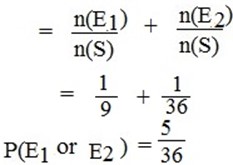
Exercise
1. A fraction is written by selecting the numerator from the digit 1,2 and 4 and the denominator from the digits 5, 6 and 7. Find the probability that the fraction written will be;
a) Less than two-third
b) Less or equal to a half
2. Two coins and a die are simultaneously tossed. What is the probability that the number less than three, a head and a tail will show up.
3. Two dice are flipped. Find the probability of getting
a) At least one 5.
b) A total score of 6.
c) A total score not divisible by 3.
4. Three coins are tossed simultaneously. Find the probability that
a) Three tails appear.
b) At least two tails appear.
c) Two heads and one tail appear.
Note:
Probabilities are expressed as fractions or percentages and obey the following rules.
i) Rule of range.
Let E be an event, then 0 ≤ P(E) ≤ 1
i.e Probability of an event lies between 0 and 1.
If P(E) = 0, then E can not occur.
If P(E) = 1, then E is certain to occur.
ii) Rule of complement.
If E is an event, then
P(E) + P(E)’ = 1
Where, P(E)’ = 1 – P(E), Where P(E)’ is the probability of an event not occurring.
MUTUALLY AND NON-MUTUALLY EXCLUSIVE EVENTS
MUTUALLY EXCLUSIVE EVENTS.
– These are events that can not occur concurrently.
– Occurrence of one event precludes the occurrence of the other event.
For mutually exclusive events, P(AnB) = 0

NON-MUTUALLY EXCLUSIVE EVENTS.
– These are events that can occur concurrently.
– The occurrence of one will not hinder the occurrence of the other. They may both occur simultaneously.
For Non-mutually exclusive events,

Example 1;
A boy contains 3 red balls, 4 blue balls, 5 white balls and 6 green balls. Which are identical. A ball is drawn at random, Find the probability that it is either;
a) red or blue.
b) red or white.
c) blue or white or green.
d) red or blue or green or white.
Solution.
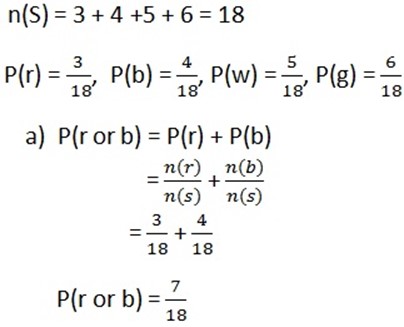
b)
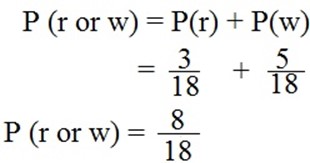
c)

Example 2;
A card is chosen at random from a standard deck of 52 playing cards. What is the probability of getting a king or a club?
Solution
The two events are non-mutually exclusive events.
P(King or Club) = P(King) + P(Club) – P(King and Clubs)
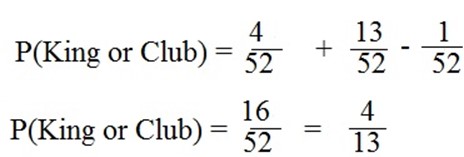
Exercise.
1. If P(A) = 0.1, P(B) = 0.9 and P(AnB) = 0.2. Find P(AuB) given that A and B are non-mutually exclusive events
2. If P(A) = 0.2 and P(B) = 0.5, Find P(AuB) given that A and B are independent events.
3. If P(A) = 1/3 and P(B) = I/2, Find P(AuB) given that A and B are mutually exclusive events.
4. Find the probability of drawing an Ace or a King in a single draw from a deck of 52 playing cards.
5. A fair die is tossed once. Find the probability of getting a number greater than three or an even number.
INDEPENDENCE AND DEPENDENT EVENTS.
INDEPENDENT EVENTS.
– Are those events in which the occurrence of one event has nothing to do with the occurrence or non occurrence of the other event.
Two events A and B are said to be independent if P(AnB) = P(A) x P(B). This is called multiplicative rule for independent events.
Example.
An electronic device has two independent components with reliability of 0.82 each. The device work only if both components are functional, What is the probability that the device will not work?
Solution
Let A be the event of first component
B be the event of second component
P(AnB) = P9A) x P(B)
= 0.82 x 0.82
P(AnB) = 0.6724
Therefore,
The probability that the device will not work.
P(AnB)’ = 1 – P(AnB)
= 1 – 0.6724
P(AnB)’ = 0.3276
Exercise
A bag contains 3black marbles and 2 white marbles.
a) A marble is taken at random from the bag and then replaced. A second marble is chosen. What is the probability that;
i) They are both black?
ii) One is black and the other is white?
b) Find the probability if the two marbles are chosen without any replacement.
DEPENDENT EVENTS.
– Are those events in which the occurance of one event affects the occurance of the other event.
– Two events A and B are said to be dependent if,
P(AnB) = P(A/B) x P(B) or
P(AnB) = P(B/A) x P(A) Where
P(A/B) or P(B/A) is conditional probability.
– It read as probability of A is given that B has occurred/ is certain to occur.
Example 1
If A and B are dependent events such that P(B) = 2/3 and P(AnB) = 1/4. Find P(A/B)
Solution
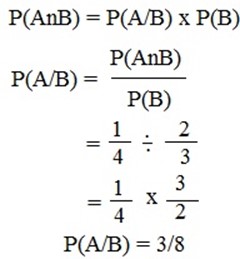
Example 2
If A and B are dependent events such that P(B/A) = 3/4 and P(A) = 1/2, Find P(AnB).
Solution.
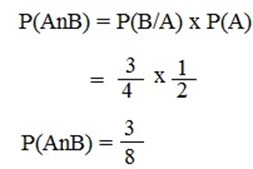
Exercise
1. A coin is tossed and a spinner numbered 1 to 7 is made to spine. Find the probability of obtaining a tail on the coin and an odd number on the spinner.
2. The names of 5 boys and 3 girls were put in a box. One name is picked at random from the box, without replacing the first name, second name is picked at random. Find the probability that both are names of boys.
3. On an interview, four out of ten interviewees got an A grade. If there interviewees are chosen at random without replacement, find the probability that all three got an A on the interview.
APPLICATION OF PROBABILITY
The applications of probability includes;
i) Budget estimates.
ii) Assessing the amount of harvest in agriculture.
iii) Lottery games.
iv) Human reproductions to plan a baby boy or girl.
v) Risk control in many aspects in our day to day life.